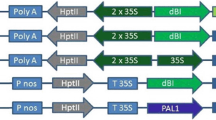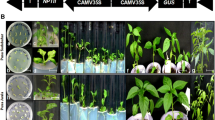Abstract
An efficient shoot regeneration method was developed using leaf explants of Populus alba × P. glandulosa, and the optimized shoot regeneration medium contained 0.1 mg L−1 NAA, 0.5 mg L−1 6-BA and 0.002 mg L−1 TDZ. The factors for Agrobacterium-mediated transformation of this hybrid were further optimized as follows: no preculture step, Agrobacterium cell suspension with an OD600 of 0.6, 20 min infection time and 2d co-cultivation duration. To investigate Populus trichocarpa cellulose synthase A4 promoter (PtrCesA4pro), we constructed the PtrCesA4pro:: β-glucuronidase (GUS) binary vector, in which the cauliflower mosaic virus 35S (CaMV35S) promoter of pBI121was replaced with the PtrCesA4pro to drive the expression of a GUS reporter gene. Forty-eight kanamycin-resistant plantlets were obtained through Agrobacterium-mediated transformation of this hybrid. Genomic DNA PCR and Southern blot analyses confirmed the integration of PtrCesA4pro::GUS into this hybrid and the expression of GUS gene was driven by the PtrCesA4 promoter. A histochemical GUS staining presented the activity of PtrCesA4 promoter in the transgenic lines. No GUS signal was observed in leaves, including the veins and petioles, and notably weak staining was detected in the secondary xylems of the roots. The PtrCesA4 promoter was highly active in the fibers, the vessels of developing xylems, and the fibers of mature phloems. Surprisingly, GUS staining was detected in the cambial cells of the highly lignified stems of these transgenic trees. Our results implicate PtrCesA4 promoter as a good genetic tool for controlling gene function in wood development and tree molecular breeding.









Similar content being viewed by others
References
Aggarwal D, Kumar A, Reddy MS (2015) Genetic transformation of endo-1,4-b-glucanase (Korrigan) for cellulose enhancement in Eucalyptus tereticornis. Plant Cell Tiss Organ Cult 122:363–371
Amutha S, Muruganantham M, Ganapathi A (2006) Thidiazuron induce high frequency axillary and adventitious shoot regeneration in Vigna radiata L. Wilezek. In Vitro Cell Dev Biol Plants 42:26–30
Atanassov II, Pittman JK, Turner SR (2009) Elucidating the mechanisms of assembly and subunit interaction of the cellulose synthase complex of Arabidopsis secondary cell walls. J Biol Chem 284:3833–3841
Choi Y, Noh EW, Lee HS, Han MS, Lee JS, Choi KS (2005) An efficient and novel plant selectable marker based on organomercurial resistance. J Plant Biol 48:351–355
De Block M (1990) Factors influencing the tissue culture and the Agrobacterium tumefaciens-mediated transformation of hybrid aspen and poplar clones. Plant Physiol 93:1110–1116
Desprez T, Juraniec M, Crowell EF, Jouy H, Pochylova Z, Parcy F, Hofte H, Gonneau M, Vernhettes S (2007) Organization of cellulose synthase complexes involved in primary cell wall synthesis in Arabidopsis thaliana. Proc Natl Acad Sci USA 104:15572–15577
Djerbi S, Lindskog M, Arvestad L, Sterky F, Teeri TT (2005) The genome sequence of black cottonwood (Populus trichocarpa) reveals 18 conserved cellulose synthase (CesA) genes. Planta 221:739–746
Doblin MS, Kurek I, Jacob-Wilk D, Delmer DP (2002) Cellulose biosynthesis in plants: from genes to rosettes. Plant Cell Physiol 43:1407–1420
Eckenwalder JE (1996) Systematics and evolution of Populus. In: Stettler RF, Bradshaw HD, Heilman PE, Hinckley TM (eds) Biology of Populus and its implications for management and conservation. NRC Research Press, Ottawa, pp 7–32
Feng F, Ding F, Tyree MT (2015) Investigations concerning cavitation and frost fatigue in clonal 84 K poplar using high-resolution cavitron measurements. Plant Physiol 168:144–155
Hamzeh M, Dayanandan S (2004) Phylogeny of Populus (Salicaceae) based on nucleotide sequences of chloroplast TRNT-TRNF region and nuclear rDNA. Am J Bot 91:1398–1408
Holsters M, de Waele D, Depicker A, Messens E, van Montagu M, Schell J (1978) Transfection and transformation of Agrobacterium tumefaciens. Mol Gen Genet 163:181–187
Husain MK, Anis M, Shahzad A (2007) In vitro propagation of Indian kino (Pterocarpus marsupium Roxb.) using Thidiazuron. In Vitro Cell Dev Biol Plant 43:59–64
Jefferson RA, Kavanagh TA, Bevan MW (1987) GUS fusions: β-glucuronidase as a sensitive and versatile gene fusion marker in higher plants. EMBO J 6:3901–3907
Ke Q, Wang Z, Ji CY, Jeong JC, Lee HS, Li H, Xu B, Deng X, Kwak SS (2015) Transgenic poplar expressing Arabidopsis YUCCA6 exhibits auxin-overproduction phenotypes and increased tolerance to abiotic stress. Plant Physiol Biochem 94:19–27
Kumar M, Thammannagowda S, Bulone V, Chiang V, Han KH, Joshi CP, Mansfield SD, Mellerowicz E, Sundberg B, Teeri T, Ellis BE (2009) An update on the nomenclature for the cellulose synthase genes in Populus. Trends Plant Sci 14:248–254
Kwon SI, Cho HJ, Lee JS, Jin H, Shin SJ, Kwon M, Noh EW, Park OK (2011) Overexpression of constitutively active Arabidopsis RabG3b promotes xylem development in transgenic poplars. Plant Cell Environ 34:2212–2224
Li H, Li M, Luo J, Cao X, Qu L, Gai Y, Jiang X, Liu T, Bai H, Janz D, Polle A, Peng C, Luo ZB (2012) N-fertilization has different effects on the growth, carbon and nitrogen physiology, and wood properties of slow- and fast-growing Populus species. J Exp Bot 63:6173–6185
Mroginski E, Rey HY, Gonzalez AM, Mroginski LA (2004) Thidiazuron promotes in vitro plant regeneration of Arachis correntiana (Leguminosae) via organogenesis. J Plant Growth Regul 23:129–134
Murthy BNS, Murch SJ, Saxena PK (1998) Thidiazuron: a potent regulator of in vitro plant morphogenesis. In Vitro Cell Dev Biol Plant 34:267–275
Noh SA, Choi YI, Cho JS, Lee H (2015) The poplar basic helix-loop-helix transcription factor BEE3-Like gene affects biomass production by enhancing proliferation of xylem cells in poplar. Biochem Biophys Res Commun 462:64–70
Porth I, El-Kassaby YA (2015) Using Populus as a lignocellulosic feedstock for bioethanol. Biotechnol J 10:510–524
Richmond TA, Somerville CR (2000) The cellulose synthase superfamily. Plant Physiol 124:495–498
Song DL, Shen JH, Li LG (2010) Characterization of cellulose synthase complexes in Populus xylem differentiation. New Phytol 187:777–790
Stevens ME, Pijut PM (2014) Agrobacterium-mediated genetic transformation and plant regeneration of the hardwood tree species Fraxinus profunda. Plant Cell Rep 33:861–870
Suzuki S, Li LG, Sun YH, Chiang VL (2006) The cellulose synthase gene superfamily and biochemical functions of xylem-specific cellulose synthase-like genes in Populus trichocarpa. Plant Physiol 142:1233–1245
Takata N, Taniguchi T (2015) Expression divergence of cellulose synthase (CesA) genes after a recent whole genome duplication event in Populus. Planta 241:29–42
Taylor NG, Scheible WR, Cutler S, Somerville CR, Turner SR (1999) The irregular xylem3 locus of Arabidopsis encodes a cellulose synthase required for secondary cell wall synthesis. Plant Cell 11:769–779
Taylor NG, Laurie S, Turner SR (2000) Multiple cellulose synthase catalytic subunits are required for cellulose synthesis in Arabidopsis. Plant Cell 12:2529–2539
Taylor NG, Howells RM, Huttly AK, Vickers K, Turner SR (2003) Interactions among three distinct CesA proteins essential for cellulose synthesis. Proc Natl Acad Sci USA 100:1450–1455
Tuskan GA et al (2006) The genome of black cottonwood, Populus trichocarpa (Torr. & Gray). Science 313:1596–1604
Wang SY, Chen QJ, Wang WL, Wang XC, Lu MZ (2005) Salt tolerance conferred by over-expression of OsNHX1 gene in Poplar 84K. Chin Sci Bull 50:224–228
Wang J, Elliott JE, Williamson RE (2008) Features of the primary wall CesA complex in wild type and cellulose-deficient mutants of Arabidopsis thaliana. J Exp Bot 59:2627–2637
Wang HH, Wang CT, Liu H, Tang RJ, Zhang HX (2011) An efficient Agrobacterium-mediated transformation and regeneration system for leaf explants of two elite aspen hybrid clones Populus alba × P. berolinensis and Populus davidiana × P. bolleana. Plant Cell Rep 30:2037–2044
Wang YJ, Pan RH, Tyree MT (2015) Studies on the tempo of bubble formation in recently cavitated vessels: a model to predict the pressure of air bubbles. Plant Physiol 168:521–531
Acknowledgments
This project was supported by Grants from the National High Technology Research and Development Program of China (2013AA102702), the Program for New Century Excellent Talents in University (NCET-12-0807), the National Key Basic Research Program of China (2012CB114502), and Project of the Natural Sciences Foundation of Heilongjiang Province (Grant C201010).
Author information
Authors and Affiliations
Corresponding author
Rights and permissions
About this article
Cite this article
Hai, G., Jia, Z., Xu, W. et al. Characterization of the Populus PtrCesA4 promoter in transgenic Populus alba × P. glandulosa . Plant Cell Tiss Organ Cult 124, 495–505 (2016). https://doi.org/10.1007/s11240-015-0909-x
Received:
Accepted:
Published:
Issue Date:
DOI: https://doi.org/10.1007/s11240-015-0909-x




